Key Differences Between Healthy Anger vs Unhealthy Anger
Anger is a natural human emotion, but not all anger is the same. Some forms of anger can be productive, helping us stand up for ourselves and address problems. Other types, however, can be harmful, damaging relationships, and affecting our mental and physical health.
Understanding healthy anger vs unhealthy anger is key to managing emotions in a way that benefits both you and those around you.
Healthy anger is controlled, thoughtful, and serves a purpose, it pushes us to take action against injustice, set boundaries, or express our needs clearly. It allows us to communicate frustrations without hurting others.
On the other hand, unhealthy anger is impulsive, destructive, and often leads to regret. It can show up as uncontrolled rage, passive-aggressive behavior, or bottled-up emotions that eventually explode.
The way we handle anger can impact every aspect of our lives, from our personal relationships to our careers.
Learning to manage anger effectively helps reduce stress, improve communication, and create a more positive mindset.
In this blog, we’ll explore the differences between healthy and unhealthy anger, the effects they have on your well-being, and strategies to manage anger in a way that leads to growth rather than destruction.
By the end, you’ll have a clear understanding of how to turn anger into a tool for positive change instead of letting it control you.
Key Points on Healthy and Unhealthy Anger
| Aspect | Healthy Anger | Unhealthy Anger |
| Definition | A constructive response to frustration that promotes positive change. | A destructive and uncontrolled emotional reaction that harms self and others. |
| Expression | Assertive, controlled, and respectful communication. | Aggressive, passive-aggressive, or suppressed outbursts. |
| Emotional Impact | Leads to self-awareness, problem-solving, and motivation. | Increases stress, anxiety, resentment, and emotional instability. |
| Physical Effects | Temporary increase in energy but no long-term harm. | Causes high blood pressure, heart issues, headaches, and fatigue. |
| Triggers | Injustice, unfair treatment, or personal boundaries being crossed. | Minor inconveniences, unresolved trauma, or deep-seated resentment. |
| Control Level | Recognized, acknowledged, and managed effectively. | Overpowers rational thinking and leads to impulsive actions. |
| Behavioral Signs | Open discussions, seeking solutions, and setting boundaries. | Yelling, physical aggression, silent treatment, or emotional withdrawal. |
| Impact on Relationships | Strengthens relationships through honest communication and conflict resolution. | Harms relationships through fear, emotional distance, and frequent conflicts. |
| Outcome | Leads to positive action, self-improvement, and resolution. | Causes regret, guilt, broken relationships, or legal consequences. |
| Management Strategies | Deep breathing, therapy, self-reflection, and healthy communication. | Suppression, explosive reactions, avoidance, or denial. |
What is Healthy Anger?
Healthy anger is a natural and constructive emotional response to situations that feel unjust, threatening, or frustrating. Healthy anger is managed in a way that promotes understanding, resolution, and personal growth.
It is an essential part of emotional intelligence and helps individuals navigate challenges effectively. Below, we explore the causes, impact, and examples of healthy anger in detail.
Signs and Symptoms of Healthy Anger
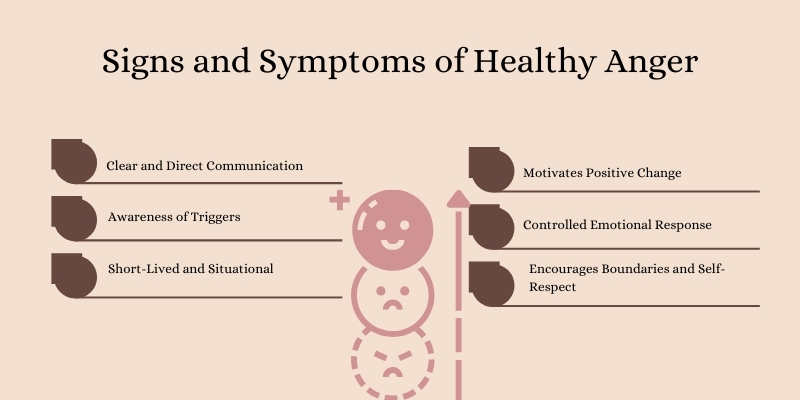
Healthy anger is a controlled and constructive form of emotional expression. It allows you to address issues without harming yourself or others. Recognizing the signs of healthy anger can help you manage conflicts effectively and use your emotions as a tool for positive change.
- Clear and Direct Communication: When anger is healthy, it helps you express your thoughts and feelings in a direct but respectful manner. Instead of yelling or being passive-aggressive, you communicate openly and focus on solutions rather than blame.
- Awareness of Triggers: People who express anger in a healthy way understand what triggers them. They can recognize situations or behaviors that provoke their anger and respond thoughtfully instead of reacting impulsively.
- Short-Lived and Situational: Healthy anger is temporary and tied to a specific situation. It doesn’t linger or turn into resentment. Once the issue is addressed, the anger fades away rather than festering.
- Motivates Positive Change: One of the key signs of healthy anger is that it leads to productive outcomes. It encourages self-improvement, strengthens relationships through honest conversations, and pushes people to take action against injustices.
- Controlled Emotional Response: Healthy anger doesn’t escalate into aggression or violence. It stays within reasonable limits, allowing the individual to remain calm enough to think clearly and make rational decisions.
Encourages Boundaries and Self-Respect: Expressing anger in a healthy way helps set personal boundaries. It allows individuals to stand up for themselves without being disrespectful or hurtful toward others.
Causes of Healthy Anger
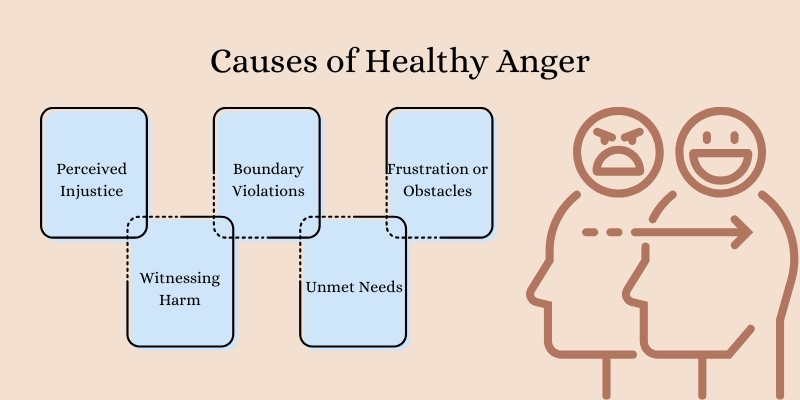
Healthy anger typically arises in response to specific triggers or situations. Some common causes include:
- Perceived Injustice: Feeling treated unfairly, whether in personal relationships, at work, or in society, can evoke healthy anger. This emotion can motivate individuals to stand up for themselves or others.
- Boundary Violations: When someone crosses personal boundaries, healthy anger serves as a protective mechanism. It helps individuals assert their needs and maintain self-respect.
- Frustration or Obstacles: Facing challenges or obstacles that hinder progress can trigger healthy anger. This emotion can fuel determination and problem-solving.
- Witnessing Harm: Seeing others being mistreated or harmed can evoke healthy anger, prompting individuals to take action and advocate for justice.
- Unmet Needs: When emotional, physical, or psychological needs are ignored or unmet, healthy anger can signal the importance of addressing those needs.
Impact of Healthy Anger
When expressed constructively, healthy anger has several positive impacts:
- Improved Relationships: Healthy anger encourages open and honest communication. By expressing feelings respectfully, individuals can resolve conflicts and strengthen relationships.
- Personal Growth: It fosters self-awareness and emotional intelligence. Understanding and managing anger helps individuals grow emotionally and develop resilience.
- Motivation for Change: Healthy anger can inspire positive action. It drives individuals to address issues, advocate for themselves, and create meaningful change.
- Stress Relief: Expressing anger in a controlled manner can release pent-up emotions, reducing stress and preventing emotional buildup.
- Boundary Setting: It helps individuals establish and maintain healthy boundaries, ensuring their needs and values are respected.
Examples of Healthy Anger
Healthy anger is expressed in ways that are respectful, constructive, and solution-oriented. Here are some examples:
- In Personal Relationships: If a partner repeatedly ignores your feelings, you might say, “I feel hurt when my concerns are dismissed. Can we talk about how to improve our communication?”
- At Work: If a colleague takes credit for your work, you could calmly address the issue by saying, “I noticed my contributions weren’t acknowledged in the report. I’d like to ensure my work is recognized moving forward.”
- In Social Settings: If someone makes an offensive comment, you might respond, “I find that comment disrespectful. It’s important to me that we treat each other with kindness.”
- Advocacy and Activism: Healthy anger can drive social change. For example, peacefully protesting against injustice or advocating for policy reforms are ways to channel anger constructively.
- Parenting: A parent might feel angry when their child breaks a rule but uses the emotion to teach a lesson. For instance, “I’m upset that you didn’t follow the rules, but let’s talk about why they’re important and how we can do better next time.”
By understanding and embracing healthy anger, individuals can navigate life’s challenges with confidence and integrity, turning a potentially negative emotion into a force for good.
What is Unhealthy Anger?
Unhealthy anger is a destructive and often uncontrolled emotional response that can harm individuals and their relationships. Unhealthy anger is characterized by aggression, suppression, or prolonged negativity.
It often stems from unresolved issues, poor emotional regulation, or underlying mental health challenges. Below, we explore the causes, impact, and examples of unhealthy anger in detail.
Signs and Symptoms of Unhealthy Anger
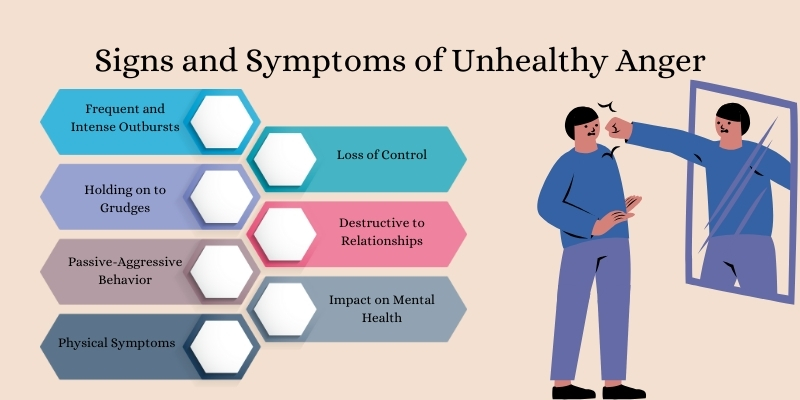
Unhealthy anger is destructive and uncontrolled. It can harm relationships, affect mental and physical health, and create ongoing stress. Recognizing the signs of unhealthy anger can help prevent its negative consequences.
- Frequent and Intense Outbursts: Unhealthy anger is often excessive and out of proportion to the situation. It may include yelling, cursing, or even physical aggression. People with uncontrolled anger tend to have frequent emotional explosions.
- Holding on to Grudges: Instead of resolving conflicts, unhealthy anger leads to long-term resentment. People experiencing this type of anger struggle to forgive and keep dwelling on past offenses.
- Passive-Aggressive Behavior: Some people don’t express their anger openly but resort to passive-aggressive behaviors such as sarcasm, silent treatment, or backhanded compliments. This indirect approach damages relationships and creates tension.
- Physical Symptoms: Uncontrolled anger can trigger physical reactions like headaches, high blood pressure, chest pain, or digestive issues. Chronic anger puts stress on the body and can contribute to long-term health problems.
- Loss of Control: Unhealthy anger often leads to actions that people later regret. Whether it’s saying hurtful things, breaking objects, or engaging in reckless behavior, this type of anger takes away rational thinking and self-control.
- Destructive to Relationships: People with unhealthy anger often struggle with relationships. Their anger may push people away, create fear, or cause others to avoid them. Over time, it can lead to isolation and loneliness.
- Impact on Mental Health: Uncontrolled anger is linked to stress, anxiety, and depression. When anger is left unchecked, it can create emotional distress and reduce overall well-being.
Causes of Unhealthy Anger
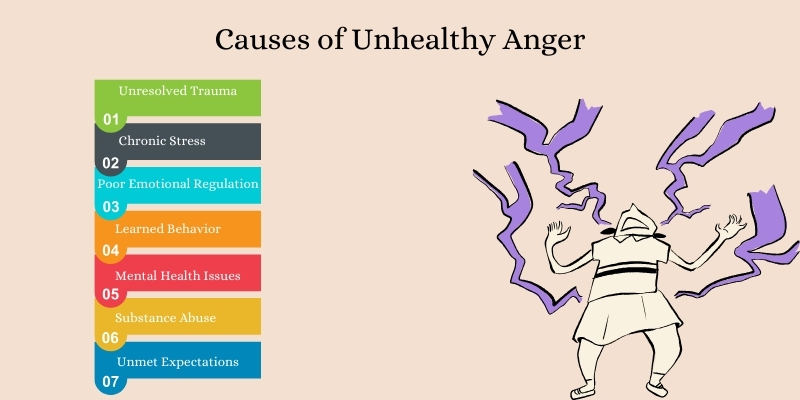
Unhealthy anger can arise from a variety of sources, many of which are rooted in unresolved emotional or psychological issues. Common causes include:
- Unresolved Trauma: Past experiences of abuse, neglect, or trauma can lead to pent-up anger that surfaces in unhealthy ways.
- Chronic Stress: Prolonged stress from work, relationships, or financial difficulties can lower emotional resilience, making it harder to manage anger.
- Poor Emotional Regulation: Individuals who struggle to understand or control their emotions may express anger in explosive or harmful ways.
- Learned Behavior: Growing up in an environment where anger was expressed aggressively or suppressed entirely can influence how individuals handle their own anger.
- Mental Health Issues: Conditions like depression, anxiety, or personality disorders can contribute to unhealthy anger patterns.
- Substance Abuse: Alcohol or drug use can impair judgment and increase the likelihood of aggressive or irrational anger.
- Unmet Needs or Expectations: Feeling consistently unheard, undervalued, or disrespected can lead to frustration and unhealthy anger over time.
Impact of Unhealthy Anger
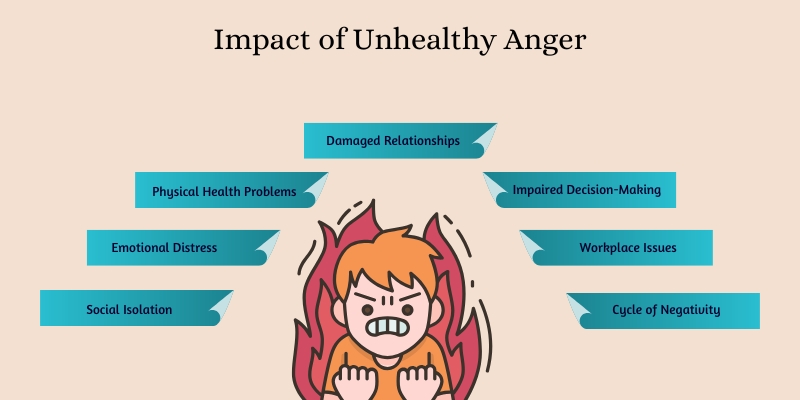
Unhealthy anger can have far-reaching negative consequences on an individual’s life, relationships, and well-being:
- Damaged Relationships: Explosive outbursts, blame, or passive-aggressive behavior can erode trust and create distance in personal and professional relationships.
- Physical Health Problems: Chronic anger is linked to health issues such as high blood pressure, heart disease, headaches, and a weakened immune system.
- Emotional Distress: Unhealthy anger often leads to feelings of guilt, shame, or regret, which can contribute to anxiety, depression, or low self-esteem.
- Social Isolation: Frequent anger episodes can push people away, leading to loneliness and a lack of social support.
- Impaired Decision-Making: Anger can cloud judgment, leading to impulsive or irrational decisions that may have long-term consequences.
- Workplace Issues: Unhealthy anger can result in conflicts with colleagues, reduced productivity, or even job loss.
- Cycle of Negativity: Unresolved anger can perpetuate a cycle of negativity, making it harder to break free from destructive patterns.
Examples of Unhealthy Anger
Unhealthy anger manifests in ways that are harmful to oneself or others. Here are some examples:
- Explosive Outbursts: Yelling, screaming, or throwing objects during an argument. For instance, slamming doors or breaking items in a fit of rage.
- Verbal Abuse: Using hurtful language, insults, or threats to intimidate or control others. Example: “You’re useless, and I can’t stand you!”
- Physical Aggression: Hitting, pushing, or engaging in other forms of physical violence. This is a severe and dangerous expression of unhealthy anger.
- Passive-Aggressive Behavior: Indirectly expressing anger through sarcasm, silent treatment, or subtle sabotage. For example, ignoring someone for days after a disagreement.
- Blaming Others: Refusing to take responsibility and instead blaming others for problems. Example: “It’s all your fault that I’m so angry!”
- Road Rage: Reacting aggressively while driving, such as honking excessively, tailgating, or engaging in confrontations with other drivers.
- Holding Grudges: Refusing to forgive or let go of past grievances, which can lead to long-term resentment and bitterness.
Unhealthy anger is a destructive force that can harm individuals and those around them. It often stems from unresolved trauma, chronic stress, or poor emotional regulation and can lead to damaged relationships, physical health problems, and emotional distress.
Recognizing the signs of unhealthy anger is the first step toward addressing it.
11 Effective Ways to Deal with Healthy and Unhealthy Anger
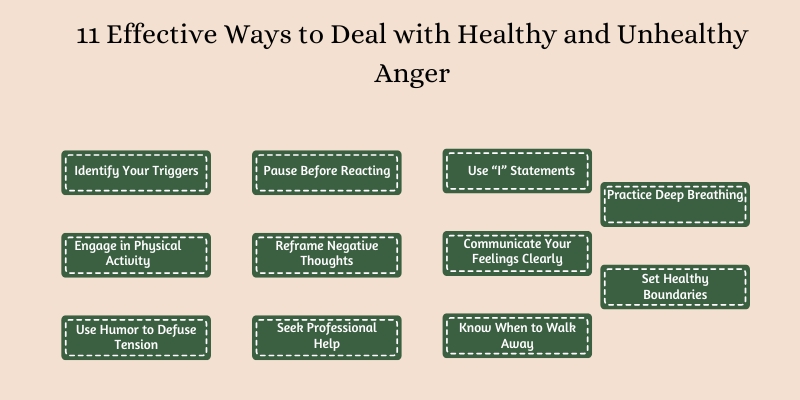
Managing healthy and unhealthy anger is key to living peacefully and improving your personal and professional relationships. Here are effective strategies to deal with anger:
1. Identify Your Triggers
Anger doesn’t come out of nowhere—it’s often triggered by specific situations, people, or experiences. Identifying what sets off your anger is the first step to managing it effectively. When you know your triggers, you can prepare for them, avoid them, or respond in a healthier way.
How to Identify Your Triggers
- Keep a Journal: Write down moments when you felt angry. Note the situation, the people involved, and what was said or done.
- Look for Patterns: Over time, you may notice recurring themes—such as feeling disrespected, ignored, or overwhelmed.
- Consider Past Experiences: Sometimes, unresolved issues from the past can make you react more strongly to certain situations.
- Pay Attention to Physical Cues: Anger often starts in the body. Clenching your fists, a racing heart, or tense muscles can be early signs.
- Ask for Feedback: Trusted friends or family members can offer insights into what they observe when you become angry.
How to Manage Your Triggers
- Plan Ahead: If you know certain situations are likely to trigger anger, think about how you’ll handle them beforehand.
- Practice Relaxation Techniques: Deep breathing, mindfulness, and visualization can help you stay calm when faced with a trigger.
- Challenge Negative Thoughts: Instead of assuming the worst, ask yourself if you’re seeing the situation objectively.
- Remove Yourself When Necessary: If a situation is escalating, stepping away can prevent unhealthy reactions.
By identifying and understanding your anger triggers, you can prevent small frustrations from turning into major conflicts.
2. Pause Before Reacting
Anger can make you act before you think, often leading to words or actions you later regret. Taking a moment to pause before reacting helps you regain control, process your emotions, and respond in a healthier way.
How to Pause Before Reacting
- Take Deep Breaths: When you feel anger rising, inhale deeply through your nose for four seconds, hold for four seconds, and exhale slowly. This signals your brain to calm down.
- Count to Ten: A simple but effective strategy—counting gives your mind a chance to reset and lowers the intensity of the moment.
- Step Away: If possible, remove yourself from the situation for a few minutes. A short walk or a glass of water can help clear your head.
- Acknowledge Your Emotions: Instead of suppressing anger, recognize that it’s a normal feeling and remind yourself that you have the power to control your response.
- Ask Yourself Questions: Before reacting, consider the question “Will this matter in an hour, a day, or a week?”
3. Use “I” Statements
The way you express anger can determine whether a conversation leads to resolution or conflict. “I” statements help you communicate feelings without blaming or attacking the other person, reducing defensiveness and encouraging productive discussions.
How to Use “I” Statements
Follow the Formula:
“I feel [emotion] when [situation] because [reason]. I would like [desired outcome].”
Example: Instead of saying, “You never listen to me,” say, “I feel frustrated when I’m interrupted because I don’t feel heard. I would appreciate it if we could take turns speaking.”
- Be Clear and Specific: Vague complaints lead to misunderstandings. Be direct about your emotions and needs.
- Stay Calm and Respectful: Tone and body language matter. A calm voice and open posture can prevent escalation.
- Use Them in Everyday Situations: Practice using “I” statements in minor situations to make them a natural part of your communication style.
4. Practice Deep Breathing
Deep breathing is one of the simplest yet most effective ways to manage anger. When you’re angry, your body enters a fight-or-flight state, causing rapid breathing, muscle tension, and an increased heart rate.
Practicing deep breathing helps activate your body’s relaxation response, reducing stress and restoring calm.
How to Practice Deep Breathing
- Find a Quiet Space: If possible, step away from the situation to a calm environment where you can focus.
- Use the 4-7-8 technique
- Try diaphragmatic breathing
- Box Breathing: Inhale for four seconds, hold for four seconds, exhale for four seconds, and pause for four seconds before repeating.
5. Engage in Physical Activity
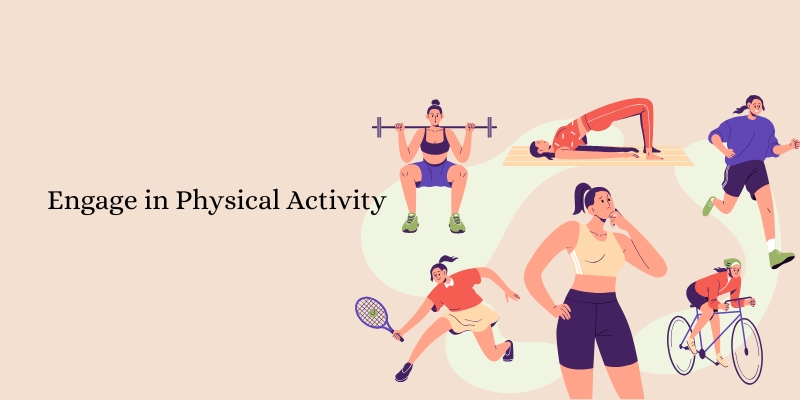
Physical activity is a powerful tool for managing both healthy and unhealthy anger. Exercise helps release built-up tension, reduce stress hormones, and boost mood-enhancing chemicals like endorphins. Instead of letting anger fester, channel it into movement.
How to Engage in Physical Activity to Manage Anger
- Go for a Walk or Run: A brisk walk or jog can help clear your mind and lower stress levels. Being outdoors also has a calming effect.
- Try High-Intensity Workouts: Activities like boxing, kickboxing, or sprinting allow you to release pent-up frustration in a controlled and healthy manner.
- Practice Yoga or Stretching: Yoga combines physical movement with breathing exercises, helping you stay mindful and relaxed.
- Lift Weights: Strength training can help redirect anger while also improving focus and self-discipline.
- Engage in Sports: Playing basketball, tennis, or any other sport can help you channel frustration into healthy competition.
- Dance or Do Aerobic Exercises: Movement-based activities like dance workouts or cycling can boost mood and relieve tension.
6. Reframe Negative Thoughts
Negative thoughts can fuel anger, making situations seem worse than they actually are. Learning to reframe these thoughts helps you gain a more balanced perspective and react in a calmer, more rational way.
How to Reframe Negative Thoughts
- Identify Cognitive Distortions: Recognize thought patterns that worsen anger, such as:
- Use Gratitude and Perspective-Shifting: Think of three things you’re grateful for in the moment.
- Practice Self-Compassion: Remind yourself that anger is a normal emotion, but you have the ability to control how you respond.
By shifting the way you think, you can transform how you handle anger, making it a tool for growth rather than destruction.
7. Communicate Your Feelings Clearly
One of the most effective ways to manage anger issues is through clear and honest communication. Bottling up emotions or expressing them aggressively can lead to misunderstandings, resentment, and conflict.
Learning to articulate your feelings in a calm and constructive manner helps prevent unnecessary escalation and promotes healthier relationships.
How to Communicate Your Feelings Clearly
- Pause and gather your thoughts
- Use “I” statements instead of “you” statements
- Stay calm and respectful
- Be specific about your needs
- Listen actively
- Use assertiveness, not aggression
By learning to express yourself clearly and respectfully, you can turn anger into a tool for positive change rather than a source of tension.
8. Set Healthy Boundaries

Healthy boundaries are essential for emotional well-being and anger management. Without them, you may feel overwhelmed, taken advantage of, or resentful, which can lead to unhealthy expressions of anger.
Setting and maintaining boundaries helps protect your energy, emotions, and mental health.
How to Set Healthy Boundaries
- Identify Your Limits: Consider what makes you feel uncomfortable or stressed in different areas of life (work, relationships, social situations).
- Communicate Boundaries Clearly: Be direct and firm when stating your boundaries.
- Learn to Say No: Saying no is not rude—it’s necessary for protecting your well-being.
- Be Consistent: People may test your boundaries at first, so stick to them firmly.
- Prioritize Self-Care: Setting boundaries allows you to dedicate time to relaxation and activities that bring you joy.
- Respect Others’ Boundaries: Just as you want your boundaries respected, be mindful of the boundaries set by others.
Setting boundaries is not about shutting people out—it’s about ensuring you have the space to manage your emotions and maintain a healthy balance in life.
9. Use Humor to Defuse Tension
Humor is a powerful tool for diffusing anger and preventing conflicts from escalating. When used appropriately, humor can lighten the mood, shift perspectives, and reduce tension in difficult situations.
However, it’s important to use humor wisely, avoiding sarcasm or jokes that could hurt others.
How to Use Humor to Manage Anger
- Find the Lighter Side of the Situation: Look for something ironic or absurd about the situation that can make you chuckle.
- Use Self-Deprecating Humor (Without Putting Yourself Down): Laugh at your own minor mistakes instead of letting them fuel anger.
- Avoid Sarcasm or Insults: Make sure your humor is lighthearted and not at someone else’s expense.
- Create an “Emergency Humor Kit”: Keep a list of funny videos, memes, or comedy routines that always make you laugh.
- Use Playfulness to Ease Tension: In a tense conversation, use humor to break the seriousness.
Humor won’t solve every problem, but it can help shift your mindset and make anger more manageable. When used appropriately, it can be a great way to release anger and foster a more positive environment.
10. Seek Professional Help

Sometimes, anger can feel overwhelming, and despite your best efforts, it may seem impossible to control. If anger is affecting your relationships, work, or personal well-being, seeking professional help is a wise decision.
Therapists or counselors can provide guidance, after through anger assessment. They can help you resolve family conflicts, list coping strategies, and provide a safe space to explore the root causes of your anger.
How to Seek Professional Help
- Find a Licensed Therapist or Counselor: Look for specialists in anger management, cognitive-behavioral therapy (CBT), or conflict resolution.
- Consider Group Therapy or Anger Management Classes: Group sessions provide a supportive environment where you can learn from others.
- Explore Online Therapy Options: If in-person sessions are not convenient, many therapists offer virtual counseling.
- Commit to the Process: Therapy is most effective when you actively participate and apply what you learn.
Seeking professional help is not a sign of weakness—it’s a proactive step toward healthier emotional control and a more fulfilling life.
11. Know When to Walk Away
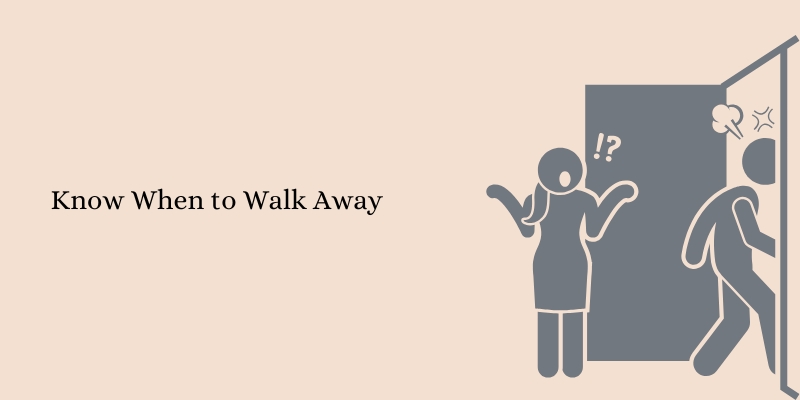
Sometimes, the best way to manage anger is to step away from a heated situation before it escalates.
Walking away doesn’t mean avoiding problems—it means recognizing when emotions are too intense to allow for a productive conversation. Taking a break can prevent regretful words or actions and give you time to regain composure.
How to Know When to Walk Away
- Recognize the Warning Signs: Increased heart rate, clenched fists, or a loud voice indicate rising anger.
- Set a Timeframe for the Break: Avoid storming off without explanation.
- Engage in a Calming Activity: Step outside for fresh air, go for a short walk, or listen to calming music.
- Return When You Feel Ready: Walking away isn’t about avoiding conflict forever.
- Knowing when to walk away is an essential skill in managing anger. It allows you to approach conflicts with a level head and ensures that your responses are measured and productive.
Frequently Asked Questions
What are the signs of unhealthy anger?
Unhealthy anger is intense, persistent, and often destructive. Signs include frequent outbursts, holding grudges, physical aggression, and difficulty calming down.
It can also lead to strained relationships, stress-related health issues, and impulsive decisions that cause regret.
Can anger ever be healthy?
Yes, anger can be healthy when it is expressed constructively. It can motivate positive change, set boundaries, and highlight important personal values.
Healthy anger is controlled, short-lived, and directed toward problem-solving rather than harming others or yourself.
How can I control unhealthy anger?
Managing unhealthy anger involves recognizing triggers, practicing deep breathing, and taking a break before reacting.
Developing emotional intelligence, seeking professional help if needed, and engaging in physical activity can also help channel anger in a healthier way.
Conclusion
Anger is a natural emotion, but how we handle it determines whether it becomes a force for good or harm.
Understanding the difference between healthy anger vs unhealthy anger is key to managing emotions effectively. Healthy anger allows you to express frustration in a controlled way, resolve conflicts, and set boundaries.
On the other hand, unhealthy anger can lead to destructive behaviors, damaged relationships, and long-term stress.
By recognizing your triggers, practicing self-care, and using techniques like deep breathing or humor, you can develop healthier ways to express anger.
Seeking professional help, setting boundaries, and cultivating empathy also play a vital role in keeping anger in check. When managed properly, anger can become a tool for growth rather than destruction.
If you find yourself struggling with uncontrollable anger, don’t hesitate to reach out for support. Learning to navigate emotions effectively takes time, but with the right strategies, you can regain control and improve your well-being.
Anger doesn’t have to control you—by making conscious choices, you can transform it into a positive force in your life.


8 Responses